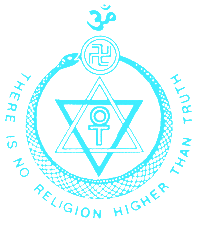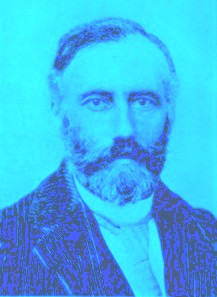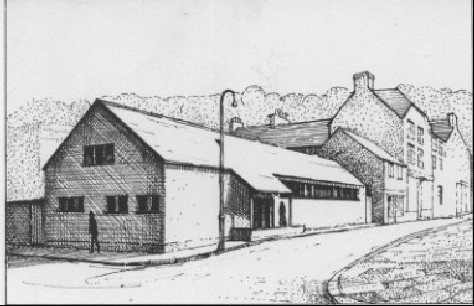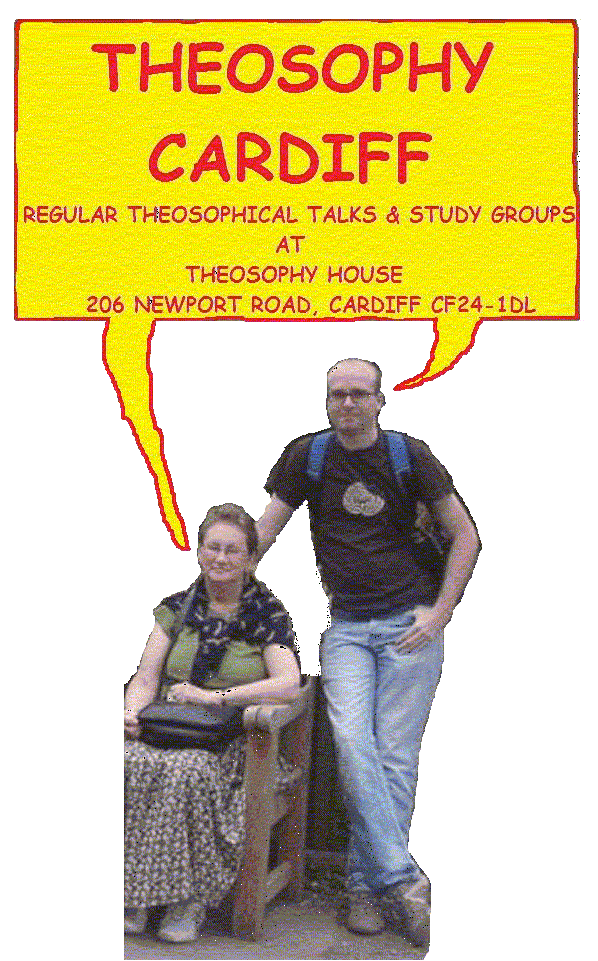THE
OF
THEOSOPHY

A Definitive Work on Theosophy
By
William Quan Judge

CHAPTER
6
The author of Esoteric Buddhism -- which book ought to
be consulted by all students of Theosophy, since it was made from suggestions
given by some of the Adepts themselves -- gave the name Kama rupa to the fourth
principle of man's constitution. The reason was that the word
I shall call it by the English equivalent -- passions
and desires -- because those terms exactly express its nature. And I do this
also in order to make the sharp issue which actually exists between the psychology
and mental philosophy of the west and those of the east. The west divides man
into intellect, will, and feeling, but it is not understood whether the
passions and desires constitute a
principle in themselves or are due entirely to the
body. Indeed, most people consider them as being the result of the influence of
the flesh, for they are designated often by the terms "desires of the
flesh" and "fleshly appetites."
The ancients, however, and the Theosophists know them
to be a principle in themselves and not merely the impulses from the body.
There is no help to be had in this matter from the western psychology, now in
its infancy and wholly devoid of knowledge about the inner, which is the
psychical, nature of man, and from this point there is the greatest divergence
between it and Theosophy.
The passions and desires are not produced by the body,
but, on the contrary, the body is caused to be by the former. It is desire and
passion which caused us to be born, and will bring us to birth again and again
in this body or in some other.* It is by passion and desire we are made to
evolve through the mansions
of death called lives on earth. It was by the arising
of desire in the unknown first cause, the one absolute existence, that the
whole collection of worlds was manifested, and by means of the influence of
desire in the now manifested world
is the latter kept in existence.
NOTE
[*W
Q Judge, in The Theosophical Forum, June,
1894, page 12, corrected this to: "in some body on this earth or another
globe."]
This fourth principle is the balance principle of the
whole seven. It stands in the middle, and from it the ways go up or down. It is
the basis of action and the mover of the will. As the old Hermetists say:
"Behind will stands desire."
For whether we wish to do well or ill we have to first
arouse within us the desire for either course. The good man who at last becomes
even a sage had at one time in his many lives to arouse the desire for the
company of holy men and to keep his desire for progress alive in order to
continue on his way.
Even a Buddha or a Jesus had first to make a vow,
which is a desire, in some life, that he would save the world or some part of
it, and to persevere with the desire alive in his heart through countless
lives. And equally so, on the other hand, the bad man life after life took unto
himself low, selfish, wicked desires, thus
debasing instead of purifying this principle. On the
material and scientific side of occultism, the use of the inner hidden powers
of our nature, if this principle of desire be not strong the master power of
imagination cannot do its work, because though it makes a mould or matrix the
will cannot act unless it is moved, directed, and kept up to pitch by desire.
The desires and passions, therefore, have two aspects,
the one being low and the other high. The low is that shown by the constant
placing of the consciousness entirely below in the body and the astral body; the
high comes from the influence of and aspiration to the trinity above, of Mind,
Buddhi, and Spirit. This fourth principle is like the sign Libra in the path of
the Sun through the Zodiac; when the Sun (who is the real man) reaches that
sign he trembles in the balance. Should he go back the worlds would be
destroyed; he goes onward, and the whole human race is lifted up to perfection.
During life the emplacement of the desires and
passions is, as obtains with the astral body, throughout the entire lower man,
and like that ethereal counterpart of our physical person it may be added to or
diminished, made weak or increased in strength, debased or purified.
At death it informs the astral body, which then
becomes a mere shell; for when a man dies his astral body and principle of
passion and desire leave the physical in company and coalesce. It is then that
the term Kamarupa may be applied, as Kamarupa is really made of astral body and
Kama in conjunction, and this joining of the two makes a shape or form which
though ordinarily invisible is material and may be brought into
visibility. Although it is empty of mind and
conscience, it has powers of its own that can be exercised whenever the
conditions permit.
These conditions are furnished by the medium of the
spiritualists, and in every seance room the astral
shells of deceased persons are always present to delude the sitters, whose
powers of discrimination have been destroyed by wonderment.
It is the "devil" of the Hindus, and a worse
enemy the poor medium could not have. For the astral spook -- or Kamarupa -- is
but the mass of the desires and passions abandoned by the real person who has
fled to "heaven" and has no concern with the people left behind,
least of all with seances and mediums.
Hence, being devoid of the nobler soul, these desires
and passions work only on the very lowest part of the medium's nature and stir
up no good elements, but always the lower leanings of the being. Therefore it
is that even the
spiritualists themselves admit that in the ranks of
the mediums there is much fraud, and mediums have often confessed, "the
spirits did tempt me and I committed fraud at their wish."
This Kamarupa spook is also the enemy of our
civilization, which permits us to execute men for crimes committed and thus
throw out into the ether the mass of passion and desire free from the weight of
the body and liable at any moment to be attracted to any sensitive person.
Being thus attracted, the deplorable images of crimes committed and also the
picture of the execution and all the accompanying curses and wishes for revenge
are implanted in living persons, who, not seeing the evil, are unable to throw
it off. Thus crimes and new ideas of crimes are wilfully propagated every day
by those countries where capital
punishment prevails.
The astral shells together with the still living
astral body of the medium, helped by certain forces of nature which the
Theosophists call "elementals," produce nearly all the phenomena of
non-fraudulent spiritualism. The medium's
astral body having the power of extension and
extrusion forms the framework for what are called "materialized
spirits," makes objects move without physical contact, gives reports from
deceased relatives, none of them anything more than
recollections and pictures from the astral light, and
in all this using and being used by the shells of suicides, executed murderers,
and all such spooks as are naturally near to this plane of life. The number of
cases in which any communication comes from an actual spirit out of the body is
so small as to be
countable almost on one hand. But the spirits of
living men sometimes, while their bodies are asleep, come to seances and take
part therein.
But they cannot recollect it, do not know how they do
it, and are not distinguished by mediums from the mass of astral corpses. The
fact that such things can be done by the inner man and not be recollected
proves nothing against these theories, for the
child can see without knowing how the eye acts, and
the savage who has no knowledge of the complex machinery working in his body
still carries on the process of digestion perfectly. And that the latter is
unconscious with him is exactly in line with the theory, for these acts and
doings of the inner man are the unconscious actions of the subconscious mind.
These words "conscious" and
"subconscious" are of course used relatively, the unconsciousness
being that of the brain only. And hypnotic experiments have conclusively proved
all these theories, as on one day not far away will be fully admitted. Besides
this, the astral shells of suicides and executed criminals are the most
coherent, longest lived, and nearest to us of all the shades of hades, and
hence must, out of the necessity of the case, be the real "controls"
of the seance room.
Passion and desire together with astral model-body are
common to men and animals, as also to the vegetable kingdom, though in the last
but faintly developed. And at one period in evolution no further material
principles had been developed, and all the three higher, of Mind, Soul, and
Spirit, were but latent. Up to this point man and animal were equal, for the
brute in us is made
of the passions and the astral body. The development
of the germs of Mind made man because it constituted the great differentiation.
The God within begins with Manas or mind, and it is the struggle between this
God and the brute below which Theosophy speaks of and warns about. The lower
principle is called bad because by comparison with the higher it is so, but
still it is the basis of action.
We cannot rise unless self first asserts itself in the
desire to do better. In this aspect it is called rajas or the active and bad
quality, as distinguished from tamas, or the quality of darkness and
indifference. Rising is not possible unless rajas is present to give the
impulse, and by the use of this principle of passion all the higher qualities
are brought to at last so refine and elevate our desires that they may be
continually placed upon truth and spirit. By this Theosophy does not teach that
the passions are to be pandered to or satiated, for a more pernicious doctrine
was never taught, but the injunction is to make use of the activity given by
the fourth principle so as to ever rise and not to fall under the dominion of
the dark quality that ends with annihilation, after having begun in selfishness
and indifference.
Having thus gone over the field and shown what are the
lower principles, we find Theosophy teaching that at the present point of man's
evolution he is a fully developed quaternary with the higher principles partly
developed. Hence it is taught that today man shows himself to be moved by
passion and desire. This is
proved by a glance at the civilizations of the earth,
for they are all moved by this principle, and in countries like France,
England, and America a glorification of it is exhibited in the attention to
display, to sensuous art, to struggle for power and place, and in all the
habits and modes of living where the gratification of the senses is sometimes
esteemed the highest good.
But as Mind is being evolved more and more as we
proceed in our course along the line of the race development, there can be
perceived underneath in all countries the beginning of the transition from the
animal possessed of the germ of real mind
to the man of mind complete. This day is therefore
known to the Masters, who have given out some of the old truths, as the
"transition period." Proud science and prouder religion do not admit
this, but think we are as we always will be.
But believing in his teacher, the theosophist sees all
around him the evidence that the race mind is changing by enlargement, that the
old days of dogmatism are gone and the "age of inquiry" has come,
that the inquiries will grow louder year by year and the answers be required to
satisfy the mind as it grows more
and more, until at last, all dogmatism being ended,
the race will be ready to face all problems, each man for himself, all working
for the good of the whole, and that the end will be the perfecting of those who
struggle to overcome the brute. For these reasons the old doctrines are given
out again, and Theosophy asks every one to reflect whether to give way to the
animal below or look up to and be governed by the God within.
A fuller treatment of the fourth principle of our
constitution would compel us to consider all such questions as those presented
by the wonder workers of the east, by spiritualistic phenomena, hypnotism,
apparitions, insanity, and the
like, but they must
be reserved for separate handling.
______________________
THE
OF
THEOSOPHY

Find out more about
Theosophy with these links

The Cardiff Theosophical Society Website
The
National Wales Theosophy Website
If you run a Theosophy Group, please feel free
to use any of the material on this site
The Most Basic Theosophy
Website in the Universe
A quick overview of Theosophy
and the Theosophical Society
If you run a Theosophy Group you
can use this as an introductory handout.
Theosophy Cardiff’s Instant Guide
One liners and quick explanations
H P Blavatsky is
usually the only
Theosophist that
most people have ever
heard of. Let’s
put that right
The Voice of the Silence Website
An Independent Theosophical Republic
Links to Free Online Theosophy
Study Resources; Courses, Writings,
The main criteria
for the inclusion of
links on this
site is that they have some
relationship
(however tenuous) to Theosophy
and are
lightweight, amusing or entertaining.
Topics include
Quantum Theory and Socks,
Dick Dastardly and Legendary Blues Singers.
A selection of
articles on Reincarnation
Provided in
response to the large
number of
enquiries we receive at
Cardiff
Theosophical Society on this subject
The Voice of the Silence Website
This is for
everyone, you don’t have to live
in Wales to make
good use of this Website
No Aardvarks were harmed in the
The Spiritual Home of Urban Theosophy
The Earth Base for Evolutionary Theosophy
A B C D EFG H IJ KL M N OP QR S T UV WXYZ
Complete Theosophical Glossary in Plain Text Format
1.22MB
Quick Explanations with Links to
More Detailed Info
What is Theosophy ? Theosophy Defined (More Detail)
Three Fundamental Propositions Key Concepts of Theosophy
Cosmogenesis
Anthropogenesis
Root Races
Karma
Ascended Masters After Death States Reincarnation
The Seven Principles of Man Helena Petrovna Blavatsky
Colonel Henry Steel Olcott William Quan Judge
The Start of the Theosophical Society
History of the Theosophical Society
Theosophical Society Presidents
History of the Theosophical Society in Wales
The Three Objectives of the Theosophical Society
Explanation of the Theosophical Society Emblem
Glossaries of Theosophical Terms
An Outstanding
Introduction to Theosophy
By a student of Katherine
Tingley
Elementary Theosophy Who is the Man? Body and Soul
Body, Soul and Spirit Reincarnation Karma
Try these if you are looking for a local
Theosophy Group or Centre
UK Listing of Theosophical Groups
All Wales
Guide to Theosophy Instant Guide to Theosophy
Theosophy
Wales Hornet Theosophy Wales Now
Cardiff
Theosophical Archive Elementary Theosophy
Basic
Theosophy Theosophy in Cardiff Theosophy
in Wales
Hey Look!
Theosophy in Cardiff Streetwise
Theosophy
Grand
Tour Theosophy Aardvark Theosophy Starts Here
Theosophy206 Theosophy Introduction
Theosophy Cardiff’s Face Book of Great Theosophists
Theosophy Evolution Theosophy Generally Stated
Biography of Helena Petrovna Blavatsky


